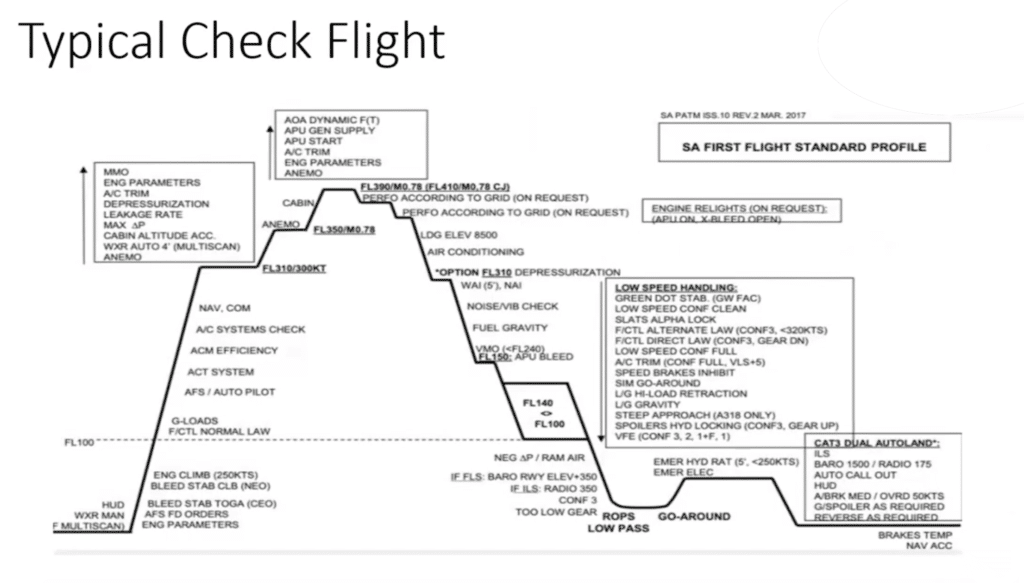Watch the presentation below or browse the highlights in the text.
Introductions
Donal Young – Accountable Manager
Captain Donal Young is the accountable manager for Technical Flight Solutions. Donal has been involved in aviation for over three decades. As a pilot, he has accumulated over 15,000 hours flying aircraft such as the Fokker 50, Boeing 737, Airbus, Airbus 320, and 330. Donal has worked extensively with a major Middle Eastern carrier and deliveries of the A320 and a 330 aircraft. He has also completed the Airbus in-service aircraft technical flight training program.
In addition, Donal has served as the general manager of an international airline in the Indian Ocean, helping to establish an operation covering both short and long-haul operations.
Technical Flight Solutions
There are many different facets of aviation, many different businesses with any aviation. Technical Flight Solutions work in an area of aviation that until recently, hasn’t been to the forefront especially of compliance and regulation, but it is becoming more and more important in the aviation industry and in the effects of getting aircraft back into the air.
“We were formed in 2018, based in Dublin. We operate to answer regulations under the control of the National Authority and the Irish Aviation Authority. Primarily, we do work in relation to maintenance check flights, delivery flights and demonstration flights on behalf of leasing companies, check and maintenance organizations on airlines.”
“I’m pleased to say that we’re actually one of the first operators within Europe who are compliant with both the part NCC ie the non-commercial complex regulations, and part MCs, specifically part SPO.SPEC.MCF maintenance check-flight regulations.”
“The key to our success is actually our crew – it’s always a people business. And I’m delighted to say that we’ve got about 50 pilots working for us at the moment. Each of the pilots has a minimum of 10,000 hours of experience. Most of them would be TRIs or TREs. All of them have been involved in the area of maintenance, check-flights, delivery, flight, demonstration flights, etc. for a number of years.”
“We’ve covered the full gamut of aviation manufacturers. We fly the full range of Airbus. We’ve laid the full range of Boeing. We conduct operations on ATR on the Embraer aircraft and we conduct operations on Bombardier aircraft. So it’s all predominantly the commercial side of the business. We do have some bizjet expertise but we see a lot of the businesses actually on the commercial side with the commercial aircraft.”
The History of Maintenance Check Flight
It’s important to understand how the regulations pertaining to maintenance check flights came to be.
Historically, people have suddenly got into the aircraft flown around the circuit, done a few checks, landed, and away you go, it’s fine. But more and more, over the last number of years, especially since 2008 in the US in particular, authorities have looked at the whole area of maintenance check flights and realized it’s been fairly unregulated and that we needed to put some structure and safety and compliance around the area of maintenance checklists.
The projects to put structure on safety and compliance around were really kicked off by an unfortunate accident in 2008 where an XL Airways Airbus A 320 was conducting a flight out of storage, exactly a maintenance check flight in the south of France.
There was an issue of water contamination. With the angle of attack sensors, on when the crew who were operating the maintenance check flight went to do some of the low-speed checks at an altitude of about 3000 feet – the ramifications of the contamination and the angle of attack sensor systems came home to bear. Unfortunately, the aircraft stalled. The crew didn’t have enough time to recover, it crashed into the sea, and all seven souls on board perished.
After that accident, the manufacturer, EASA and the companies involved looked at the cause and effects of the actual crash itself. And when they realized, “hold on a second, there is no regulation here to govern higher maintenance check gliders to be conducted”, the project of regulating this area of operation kicked off.
First, with notice proposed amendments that went through the process of comprehensive common and response documents. Then eventually in 2019, EASA also published the part SPO.SPEC.MCF maintenance check flight regulations.
“At this time, my colleagues and myself had been involved in doing maintenance check flights, especially for organizations in the Middle East. We had gone through technical training programs, so we knew this legislation was coming into effect. We set up our organization to embrace the regulation and to provide to companies that need the service. We knew that the organizations in the future would not be able to conduct maintenance check flights, delivery flights and demonstration flights other than through an operator such as ourselves, with an operational structure, a safety management system, a flight ops department and applicable training department.”
“We have exactly what you’d expect to see within a large organization such as an AOC or an airline, but actually within the confines of part NCC, part SPO.SPEC.MCF and with the surety that they’re dealing with an organization that embraces safety management, embraces compliance and embraces training as the pillars of our foundations.”
What is a Maintenance Check Flight?

The technical flight profile above is the common profile for an Airbus A 320 aircraft on an acceptance flight, or scheduled maintenance check flight.
In the bottom left-hand corner, that’s your takeoff. And after the takeoff, you’re checking:
- Engine parameters
- Flight directors
Through 10,000 feet above 10,000 feet, you’re checking:
- Autopilot
- Aircraft systems to make sure that your hydraulics are working
- Bleed air system
- Electrical system
Above flight level 300. you’re checking:
- Pressurisation depressurization
- Leak checks
- High speed protections
- APR with 39,000 feet
After that, when you’re starting your descent again, you’re doing:
- Air traffic control checks
- VHF radio
- HF radio
When you get down towards play level 140 and flight level 100 you’re doing a lot of the fairly detailed technical checks such as:
- Low speed protection
- Simulating a gorons
- Alternate gear gravity extension check to make sure that if something happens to the landing
- Gear normal system
- Gravity extension
So when all that is done, when you’re coming into land, you again check some of the systems you may extend:
- Ram air turbine to check your
- Backup electrical generation
- Full landing capability
- Online system
“As you can see, it’s not a normal face. Hence, the level of training and expertise that we require from our pilots to conduct this type of flight safely and without threats is extremely high.”
Getting Aircraft back in the Air

It’s not something you see very often – it’s just two aircraft from this particular photograph, with the covers and the engine on the aircraft just left there on the ice and snow.
“Really, this photograph brought home to me the effect of COVID-19.”
Last year in the middle of 2020, there were 17,000 aircraft grounded throughout the world, in 900 different locations. That’s a staggering amount of aircraft. Many of them were the workhorses that we use every day, they were the 320s.
“I’m delighted to say actually that over the last two or three months, we see more and more and more of the 707s and 320s, the workhorses of the industry, returning to service and getting back into the air. We’ve all heard about the 380s in the news in the media, and we’re not seeing them returned to the air, we’re seeing some of the older generation 340s simply not being fuel-efficient enough to return to the air. They’re too costly to maintain, they’re too costly to run.
Common Occurances by Animals
Animal occurrences are most common in aircraft that are stored especially in warmer climates – more dry, higher temperature and humid, are very common. Some of them are:
- Pilot tube comtamination by wasps/bees
- Nesting birds
- Animal rodents
Common Technical Issues
- Navigation data base validity
- Engine start issues
- Systems (hydraulic / electric / bleed air)
“Most of our aircraft that we fly these days are like performance cars. If they’re not used on a regular basis, they don’t like it. Aircraft do not like sitting on the ground.”
“These are the types of things that our crew would brief before they do a flight. What would happen if we lose a hydraulic system? What would happen if we lose two hydraulic systems? What would happen if the aircraft doesn’t pressurize? What would happen if the aircraft depressurizes?
“This is why the maintenance checkflight is so important, because you want to check that aircraft before you put a standard Commercial Crew into the aircraft with 150 passengers, 250 passengers or even 300 passengers. It is so important to make sure that an aircraft when it comes out of a storage programme, or an approved maintenance programme, does exactly what it is supposed to do.”
Common Crew and ATO issues
- Skill-fade
- Recency
- Confidence
“Everybody’s talking about skill fade because we haven’t been flying. Some crew haven’t been flying for the last year, year and a half. That leads to the technical issue of recency, being your medical recency, learning recency, license recency. You come through attestation recency, country medical recency, safety and training recency, etc, etc. But again, that is well covered with the asset documentation on the asset guidance.”
“One thing that I haven’t seen many people talk about is confidence. And I see confidence as a big factor in returning to operations. I have many pilot friends who know they’re suffering from skill fades, that haven’t flown for six or seven or eight or 10 or 12 months, whose recency is gone, etc.”
“The one thing I see is a lack of confidence. I see that they don’t have the same confidence that they had a year and four months ago. And I think that’s something that’s going to have to be addressed with all avenues of aviation and all avenues within the business.”
“Confidence leads on to the big issue of mental health. And I think that’s coming more and more to the fore as well. I know a lot of operators that we work with are actually very aware of the whole issue of mental health, stress on their employees. It’s a big issue and it’s going to continue to be a big issue until we get back in the air.”
Technical Flight Solutions Services
“We do check flights on aircraft within the storage programs. So if an aircraft is doing a short-term storage program, it might have to be flown every 90 days. If an aircraft does a long-term storage program, we may have to go long after it’s been in for six months and fly it just to exercise the aircraft.”
“We would work with the check maintenance organization, the owner of the aircraft, the original equipment manufacturer, and we’d say okay, we need to check x, y and z on this flight. We brief the pilots before they get into the aircraft, check the systems are operational and off we go.”
Other flights include:
- Maintenance check flights covering the full profile
- Maintenance storage flights, short-term or long-term storage programs
- Ferry flights to or from parking facilities
- Ferry flights on behalf of new aircraft owners
- Demonstration flights on behalf of new aircraft owners/operators
Technical Flight Solutions Crew
“We are a captain’s only organization, which is rare these days. Our crew has at least 10,000 hours of flying behind them. The average is actually 15,000 hours, which is quite an amount of flying. All of our crew have typically worked for large airlines in Europe, the Middle East, the Far East, the states. Most of them have also worked in smaller airlines, have experience of either the business jet world or the cargo jet world or would be instructors or examiners.”
“So we have quite a high talent pool of crew and we need that because our area of operation, we need the experience, we need the experience of crew member that when the engine doesn’t do as it should do at 37,000 feet, they know what’s going to happen next and they know this is not standard.”
“We employ crew with a can-do attitude, with excellent technical and excellent regulatory knowledge. Because everything we do is under the eyes and ears of our National Authority. We have to do it in compliance with the regulations.”
“Every crew member that we have undergoes an operator conversion course, specifically to the technical flight solutions, standards and procedures. We review what’s called the ‘in the service aircraft technical flight profile training’. We review the training that the people have done in being able to conduct the in-service aircraft technical flight profile.”
“To do a typical maintenance check flight training program, you’re looking at two days of ground school, two to three days in the simulator, and you’re looking at another two days of exercises in the aircraft. And that’s in addition to all your normal licensing requirements as recurrent training for licensing and operations proficiency that you do on a yearly basis anyway.”
Why use Web Manuals?
“There are a lot of document management systems out there but Web Manuals makes you feel as if you’re part of a family. The customer response is excellent. The teaching about Web Manuals was excellent. The product is fairly easy to use.”
“Where it helps us the most is in the whole area of compliance. Our manuals are structured that we can show OEMs to leasing companies to CAMOs where our maintenance check flight operations manual reflects the compliance tags of part SPO.SPEC.MCF. For me, that’s gold.”
“Because when I look at a web-based manual with a compliance tag, that I can link it back to the regulation. I can say they do it because of these compliance requirements when somebody is asking me why my pilots do a briefing before a maintenance check flight. And I can show them, “here’s how we comply”.
“The other two things. It’s the same as everybody else. Distribution is a great channel. It’s easy. And then the whole process of amendments. Being able to access a manual in real-time, amended in real-time, highlight those revisions to see the change that you made, especially if you want to submit it to a National Authority, is key.”
Do you think people will fly less or more after the pandemic?
“My feeling is it’s going to take two to three years to get back to where we were in 2018 and 2019 levels. I’ve looked at the news recently. KLM is looking at 50% of travel for this summer. Next summer, it’s going to be 60 or 70%. Then, it’s going to be 80 or 90%. By 2023 is my hunch.”
“But I think what’s going to be guiding the whole travel industry over the next five to 10 years is green credentials. Yet, people want to travel, only now people are going to be more aware of green credentials, which may take back travel a little bit in the medium to long term until we get smarter and more environmentally friendly about how we travel.”
Any final advice to operators that need to take the aircraft out of storage quickly?
“People need to be thinking at least two months in advance. Yeah, it is a gamble. We’re seeing some of the regional carrier carriers within Europe considering, can we take ATR aircraft? Can we take Embraer aircraft? Can we take some 327 337 aircraft? Can we take the risk of taking their motor storage?”
“The big cost is training the crew in anticipation of a relaxation of travel restrictions. It’s easier to do it on a 320 on an ATR platform than it is on a 333 50 triple seven platform. Because the costs aren’t as high. But once you take crew out of furlough or redundancy and do their validations, we should start flying. Again, we all need to be careful about letting them sit in the ground again for another 45 days or another 90 days, because they haven’t been flying for maybe a year.”
“You can’t expect them to go into an aircraft again, after 90 days of not flying unperformed to normal ops, you just can’t. You’re really looking at two months in advance.”
“Looking at planning for capacity. Instead of 25%, plan for 40% capacity. Because if 40% capacity works great, you can ramp it up to 50% relatively straightforward and in the same way you can ramp it back down to 30 or 35% relatively straightforward. But don’t plan to go from 25% capacity to 60% capacity, it’s too big of a jump. You’re going to affect the safety of your organization if you try to put too much strain in there.”




